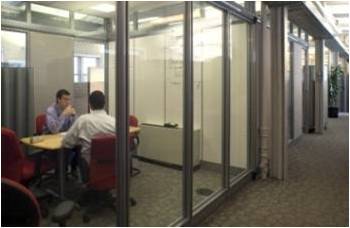Sense of Place
What makes a workplace special? What fosters a sense of attachment, engagement and identity? These are the kinds of questions that underlie the sense of place. The workplace is increasingly seen as a “brand” that conveys not only a place, but also the mission and values of the organization. The GSA workplace program combines branding and sense of place with sustainable approaches to create special places imbued with meaning and purpose.
Achieving Both Sense of Place and Sustainability: Key Practices
- Make the front door special – the entrance to the workplace, including the doorway and reception area, should set the stage for the impressions created by the workplace.
- Use the organization’s mission and values to guide design - the workplace design should make the organization’s culture, values and business visible to all.
- Showcase local natural materials and artifacts – use local materials, artisans, and design expertise to create a workplace grounded in the regional ecology.
- Value the local environmental context -- creating a sense of place means recognizing where you are. The desert Southwest is a very different place from the rainy Northwest. The workplace should reflect this through its use of daylight, views, design motifs, and natural resources.
- Color matters -- People seek out and enjoy colorful artifacts and spaces. Yet many of our work environments are seas of gray and beige with little color relief. Adding color with accent walls, artifacts, and furnishings can turn a dull space into an inspired one.
Benefits:
Social:
- Improved employee morale
- Improved connection to the organization’s mission
- Improved overall satisfaction with the workplace
Economic:
- Contributions to the local economy
- Reduced costs of transporting materials from afar
Environmental:
- Attention to regional and local resource concerns
Case Study Results: San Antonio, Public Buildings Service
Strategy
The PBS office in San Antonio used a workplace renovation to create a space that would inspire confidence in its customers while also reflecting its South Texas location and a strong concern for the environment.
Implementation
The design criteria included:
- A space that addressed the changing nature of work
- Openness and light in all areas
- Festive colors reflecting the spirit of San Antonio
- Water themes and patterns symbolizing the River Walk
- Use of sustainable materials throughout
Project Checklist
- The workplace entrance presents a welcoming image
- The mission and work of the organization are conveyed through the design
- Occupant survey shows that the office conveys a professional image appropriate to the organization
- Procedures are in place to assure that design excellence is maintained throughout the life of the workplace design
- The design uses local materials and services
- Sustainable materials are used throughout the space
- Public transportation is readily accessible from the workplace location
- Navigation of the workplace is easy due to adequate views and reference points
- A registered architect or interior designer was a primary consultant on the project
- Color is used to provide visual interest and cultural connections to the building locale
- Window views provide a connection to the outdoor environment and landscape.
- Window views are available to all.
Source(s): U.S. General Services Administration,"The GSA Hallmarks of the Productive Workplace", Rev. 01/06, 1999.
Gallery
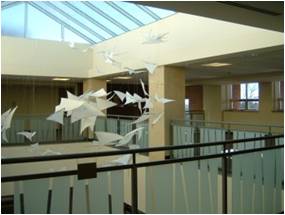
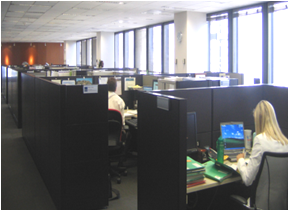
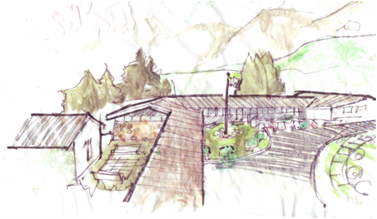
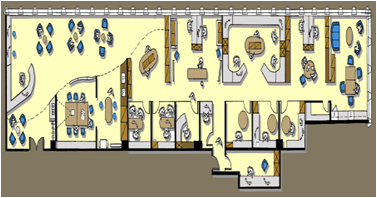
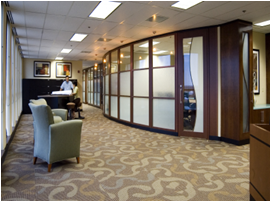
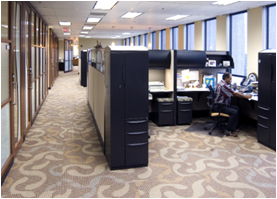
Related Topics
Institutional Change
Institutional change refers to the process of designing and implementing new ways of doing things that can persist over time. In the realm of sustainability, institutional change means finding new ways of work that are less resource intensive, while continuing enable agencies to meet their mission goals. Institutional change integrates behavior with technologies and policies, recognizing that all three need to align to make a significant and lasting difference. More information on key principles and strategies to promote institutional change can be found on the DOE-Federal Energy Management Program Institutional Change website: http://energy.gov/eere/femp/institutional-change-sustainability![]()
Occupant Satisfaction
A primary goal of sustainable design is to maximize occupant comforst and satisfaction, while minimizing environmental impact and costs. Comforst and satisfaction are important for many reasons, not least of which is that they correlate positively with personal and team performance. The greater the satisfaction, the higher the productivity and creativity of an organization. It has also been demonstrated that occupant satisfaction impacts staff rentention.
Regionally Sourced/Harvested/Extracted
Most materials, goods and products travel a far distance via ship, train or truck before arriving at their final destination. The impacts associated with transporting those goods and products can be significant – added traffic congestion, increased greenhouse gas emissions, and worsening of air pollution. By selecting products that are locally sourced, the impacts of transportation are minimized. Additionally, choosing local or regional materials supports the local economy.
Sense of Place
Space Reconfiguration and Renovation
As needs change over time, tenants often need to convert space or phase the conversion of individual space or rooms to meet these changing needs.
Worker Productivity
Productivity is the quality and/or quantity of goods or services produced by a worker. Good indoor environmental quality – access to views, comfortable temperatures, comfortable lighting, good acoustics, and ergonomic design, etc. – supports employees’ ability to do a good job. On the other hand, compromised IEQ hinders their ability to work. It makes good business sense, then, to keep employees happy, healthy, and productive. This, in turn, creates more and higher quality output for organizations.

